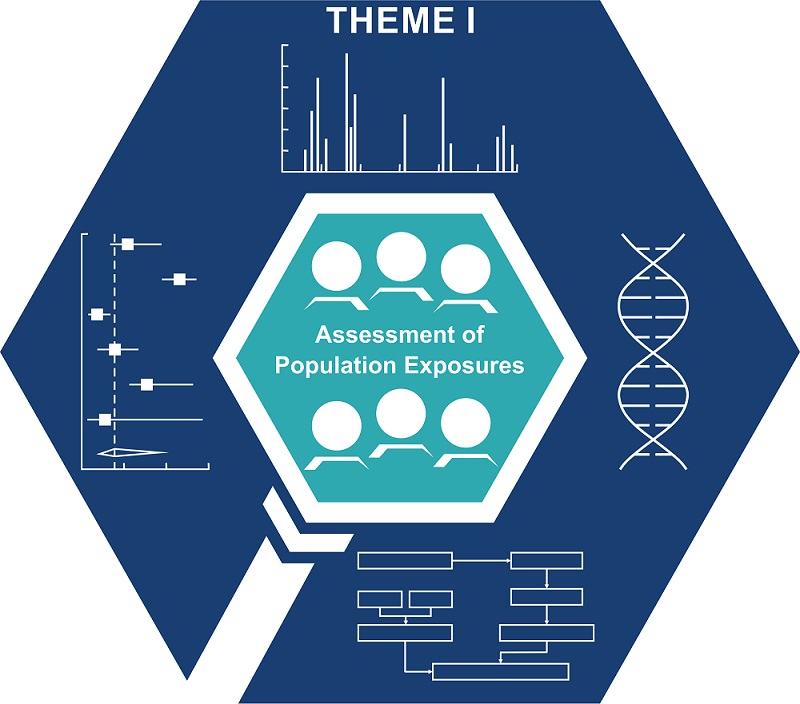Theme I - Assessment of Population Exposures
Overview
The Chief Medical Officer’s 2017 annual report and the Toxic Chemicals in Everyday Life Inquiry by the Environmental Audit Committee (EAC) both highlight the need for robust research to quantify UK exposures to environmental hazards. This theme combines direct and indirect methods of exposure assessment to improve our exposure knowledge. Human biomonitoring (HBM) and air sampling (both outdoor and indoor) will determine exposures to chemicals, metals, gases, nanoparticles, bioaerosols and e-cigarettes within sample populations. Modelling tools will be developed to predict UK population exposures.
Theme Leads
Professor Benjamin Barratt

Theme I Co-Lead
Environmental Research Group, School of Public Health, Imperial College London
Professor Ben Barratt is a Reader in Environmental Exposures & Public Health and Deputy Director of the Environmental Research Group, and Theme I Co-Lead for the HPRU in Environmental Exposures and Health.
EEH Themes:
Theme I Project 6: Indoor Air Pollution
Theme II Project 3: Indoor exposures and health
Theme II Project 4: Exposures in transport microenvironments and their impact on health
Publications:
Dr Emma Marczylo

Theme I Co-Lead
UK Health Security Agency
Dr Emma Marczylo is a Principal Toxicologist within the Radiation, Chemical and Environmental Hazards Directorate at the UK Health Security Agency with over 20 years’ postdoctoral experience in toxicological research disciplines, including cellular and molecular biology, epigenetics, toxicogenomics, in vitro and in vivo model systems and the microbiome. Her current research focuses on the potential toxicities of e-cigarettes and on characterising fungal bioaerosol exposures and their associated public health outcomes. As part of her role at RCE, Emma is also involved in academic teaching, expert workshops, regulatory and policy meetings, and providing advice to government departments and agencies. Emma co-leads Theme I: Assessment of Population Exposures within the Environmental Exposures and Health HPRU.
EEH Themes:
Theme I Project 5: Bioaerosol quantitation and effects
Theme II Project 4: Exposures in transport microenvironments and their impact on health
Theme IV Project 2: Microplastics and Health
Publications:

Theme I Projects
Project outline: HBM of human samples is used to determine exposures to potential toxicants, typically using blood or urine. UKHSA is the UK lead for the Human Biomonitoring Initiative for Europe (HBM4EU). This project will build on the HBM4EU work to determine background chemical exposure levels within the English population.
Project outline: In collaboration with KCL, UKHSA has developed a policy on e-cigarette use for tobacco harm reduction. This project will address some outstanding safety and behavioural issues associated with e-cigarette use in three at-risk populations; 1) Pregnant women, 2) Vape shop workers and 3) Mental health patients.
Project outline: Acute CO poisoning is associated with lasting neurotoxicological effects. This Gas Safety Trust funded EDCO study is using patients attending Emergency Departments with symptoms typical of CO exposure to determine exposure prevalence. Additionally, untargeted metabolomics will be conducted to identify better biomarkers of CO exposure. This project will inform policies to mitigate health impacts.
Project outline: Domestic access to consumer products using advanced materials, especially nanomaterials, increases the potential for inhalation exposures to materials with ill-defined hazard profiles. The characteristics of aerosols produced during their use are not well understood. Thus, the objective of this project is to measure the concentrations, chemical content, temporal and size distributions of these aerosols to estimate indoor exposures to inform risk assessments.
Project outline: Previous HPRU studies indicated a need for improved bioaerosol exposure assessment, particularly bioaerosol dispersion models to replace distance as a proxy of exposure, and studies that combine exposure and health outcomes. Fungi are of particular interest as they are present in both outdoor and indoor air and are associated with asthma, allergies and complications in other respiratory diseases. This project will use molecular techniques, including metabarcoding, to better characterise the fungal composition of bioaerosol exposures within different environments; perform epidemiological studies with better measures models of bioaerosol exposure and determine cellular responses to fungal bioaerosols in vitro.
Project outline: Indoor air contains particulates, bioaerosols and chemicals that can adversely impact human health. This project will develop a microenvironmental exposure model to predict indoor concentrations of volatile organic compounds (VOCs) and semi volatile organic compounds (SVOCs) in the home environment. Predicted exposures will be compared with experimental indoor VOC and SVOC measurements for validation. Predicted concentrations will be combined to assess cumulative risk from exposure to the most frequently occurring and health relevant VOCs and SVOCs. PCIEP methods will be used to research public perceptions of exposures and evaluate effective methods to communicate risk.
Theme I Investigators
Dr Leon Barron

Investigator
Environmental Research Group, School of Public Health, Imperial College London, Imperial College London
Dr Leon Barron moved to King’s College London as a Lecturer (in 2009) and then Senior Lecturer (in 2015) in Forensic Science, where he led the Environmental & Forensic Chemistry group for 11 years. In 2020, he moved to Imperial College London as a Senior Lecturer in Analytical & Environmental Sciences. He has published >75 peer-reviewed articles in the fields of analytical chemistry, environmental pollution, ecotoxicology and forensic science.
EE&H Projects:
Theme I Project 1: Human Biomonitoring
Dr Alison Buckley

Investigator
UK Health Security Agency
EEH Themes:
Theme III Project 6: Use of improved in vitro systems to evaluate mechanisms of toxicity
Publications:
Shiv Chauhan

Research Associate
UK Health Security Agency
Shiv Chauhan is a Higher Toxicologist in the General Toxicology and Biomonitoring Programme. This programme sits in the Radiation, Chemical and Environmental Hazards Directorate at the UK Health Security Agency. Shiv has graduated from the University of Central Lancashire with a Bachelors in Medical Sciences.
EEH Themes:
Dr Sani Dimitroulopoulou

Investigator
UK Health Security Agency
Dr Sani Dimitroulopoulou is a Principal Environmental Public Health Scientist on Indoor Environments at the UK Health Security Agency. She is also an Honorary Senior Lecturer at the UCL Bartlett School. Her interests include exposure assessment to air pollution, based on modelling and monitoring of indoor and outdoor air pollution and ventilation as well as health impact assessments. She has led and participated in more than 40 research and consulting projects. She has published about 90 peer-reviewed papers in international scientific journals and conferences and more than 45 technical research and consulting reports on the above research areas. She works closely with colleagues from Government Departments (e.g. DfE, MHCLG, Defra, BEIS) and Organisations (e.g. WHO, NICE, CIBSE), and Royal Colleges (RCP/RCPCH) to provide expert advice on indoor air quality and health.
EEH Themes:
Theme I Project 3: Acute CO exposure
Theme I Project 6: Indoor Air pollution
Publications:
Dr Atallah Elzein

Investigator
UK Health Security Agency
Dr Atallah Elzein carried out his PhD in chemistry and environmental sciences in CNRS/Orléans – France, where I studied the interaction of gas pollutants on the surface of mineral oxides. Following my PhD, I took up a postdoctoral position at ULCO University in France where I expanded my experience in atmospheric science and air pollution and investigated the VOCs reaction kinetics and product formation using simulation chamber. I moved to York in the UK in 2016 and took up a postdoctoral position in WACL at the University of York where I focused on studying the chemical composition of PM2.5 in Beijing and Delhi and health risk assessment from carcinogenic compounds. Currently working at the UK Health Security Agency in the department of toxicology in Chilton-Harwell Campus where I’m involved in different projects within the HPRU focusing on health protection from toxicants in indoor and outdoor air.
EEH Themes:
Theme I Project 1: Human Biomonitoring
Theme I Project 3: Acute CO exposure
Theme III Project 4: E-cigerettes toxicity and health effects from second-hand exposures
Theme IV Project 5: Understanding exposures to toxicants from waste fires
Publications:
Dr Karen Exley

Investigator
UK Health Security Agency
Her research focuses on environmental public health with specific interests in improving exposure and risk assessment of indoor and outdoor air pollution and environmental chemicals. It also includes evaluating the effectiveness of interventions for both indoor and outdoor air quality and translating this knowledge into actionable public health tools and guidance for national and local government and other stakeholders.
She is a member of the scientific secretariat for the Committee on the Medical Effects of Air Pollutants and was an expert committee member for the National Institute for Health and Care Research (NIHR) Excellence’s Quality Standard on air pollution. She is a Member of the UK Research & Innovation Strategic Priorities Fund’s Clean Air Steering Committee and a Member of the National Institute of Health Research’s Public Health Research Funding Committee.
EEH Themes:
Theme 2 Project 1: Air pollution and adverse birth outcomes
Theme 2 Project 5: Disentangling effects of NO2 and PM2.5 in time-series analysis
Publications:
Muhammad Saleem Khan
Investigator
Dr. Khan is an epidemiologist and biostatistician with a PhD in Public Health from Imperial College London, where his doctoral research explored the impact of environmental factors on cystic fibrosis disease severity using spatio-temporal analysis. He also holds an MPH from Imperial College London and an MSc in Epidemiology and Biostatistics from Aga Khan University, Pakistan.
Currently, Dr. Khan’s research focuses on the long-term effects of air pollution on lung function in individuals with cystic fibrosis, using data from the UK CF Registry. Additionally, he investigates trends in diabetes management outcomes, including HbA1c levels, hospital admissions for diabetic ketoacidosis, and severe hypoglycemia in adults with type 1 diabetes, using data from the National Diabetes Audit NHS England (2007/08 – 2022/23).
EEH Themes:
Dr Charlotte Landeg-Cox

Investigator
UK Health Security Agency
Charlotte Landeg-Cox is an Environmental Public Health Scientist at the UK Health Security Agency’s Centre for Radiation, Chemical and Environmental Hazards. Charlotte has a BA (Hons) from Liverpool John Moors University and an MSc in Environmental Health from UWE Bristol. Charlotte currently works in the Air Quality and Public Health team within the Environmental Hazards and Emergency department and has experience of acute and chronic incident response, research, evidence translation and communicating public health risk assessments. Charlotte is also a STEM Ambassador and participates in outreach events and activities.
EEH Themes:
Theme I Project 6:Indorr Air Pollution
Publications:
Dr Adam Laycock

Investigator
UK Health Security Agency
Adam Laycock is a Senior Scientist in the Nanoparticle Inhalation Research Group within the Toxicology Department at the UK Health Security Agency. He is an analytical chemist with expertise in metal analysis and particle detection and characterisation in a range of consumer product, environmental, and biological matrices.
EEH Themes:
Theme I Project 2: Biomarkers in smoking and vaping populations
Publications:
Justie Mak

Investigator
Environmental Research Group, School of Public Health, Imperial College London
Justie Mak is a final year PhD student. She is part of the Aerosol Science team in the Environmental Research Group and the Lungs at Work team at the National Heart and Lung Institute.
PhD: The risk of occupational exposure to subway particulate matter on cardiorespiratory health in London Underground workers.
EEH Themes:
Professor Ann McNeill

Investigator
King’s College London
Ann McNeill is Professor of Tobacco Addiction in the National Addiction Centre, Institute of Psychiatry, Psychology & Neuroscience (IoPPN), King’s College London. She was also the inaugural Vice Dean (Culture, Diversity & Inclusion) for the IoPPN. Ann’s research focuses on reducing the population level impact of smoking through the application of tobacco control policies and interventions, including harm reduction strategies. Ann has led six evidence updates on e-cigarettes commissioned by UK government which involve original research and reviews of the evidence. She has a particular focus on disadvantage and smoking, including understanding and reducing the much higher levels of smoking observed in those with mental health problems. Nationally, she co-chairs a Mental Health and Smoking Partnership, a coalition of stakeholders interested in reducing smoking, led by the charity Action on Smoking and Health. She is also Co-Director of a newly funded NIHR Policy Research Unit in Addictions. Ann has published more than 450 peer-reviewed academic papers. She has an established international reputation in tobacco addiction, receiving a World Health Organisation World No Tobacco Day award for contributions to tobacco control in 1998 and in 2020, the Doll-Wynder Award by the Society for Research on Nicotine and Tobacco.
Theme I Project 2: Biomarkers in smoking and vaping populations
Theme III Project 4: E-cigarettes toxicity and health effects from second-hand exposures
Publications:
Dr Tim Marczylo

Investigator
UK Health Security Agency
Dr Tim Marczylo Ph.D., B.Sc. is a principal toxicologist and leads a small team within the Toxicology Department at the Centre for Radiation, Chemical and Environmental Hazards, UK Health Security Agency. His main research focus is on the exposure of the public to potentially damaging environmental toxicants and their health consequences. Recently, research has focussed on biomarkers of electronic cigarette exposure and on evaluating mass casualty decontamination strategies.
EEH Themes:
Theme I Project 1: Human Biomonitoring
Theme I Project 2: Biomarkers in smoking and vaping populations
Theme I Project 3: Acute CO exposure
Theme I Project 6: indoor Air pollution
Theme III Project 4: E-cigarettes toxicity and health effects from second-hand exposures
Theme IV Project 2: Microplastics and health
Theme IV Project 3: Drugs of misuse
Theme IV Project 5: Understanding public exposures to toxicants from waste fires
Publications:
Dr Christina Mitsakou

Investigator
UK Health Security Agency
Christina has participated into several research projects whilst working in JRC Ispra (1999-2000), NCSR Demokritos (2001-2007), University of Athens (2007-2011), King’s College London (2011-2014), University of Cambridge (2015). Since November 2015, she has been working at the UK Health Security Agency on the health effects associated with exposure to air pollution.
EEH Themes:
Theme 1 Project 6: Indoor Air Pollution
Publications:
Dr Ian Mudway

Theme II Co-Lead
Environmental Research Group, School of Public Health, Imperial College London
EEH Themes:
Theme I Project 3: Acute CO exposure
Theme II Project 2: Air pollution/impacts on the brain across the life course
Theme II Project 4: Exposures in transport microenvironments and their impact on health
Theme III Project 2: Health effects of non-combustion particles
Theme III Project 3: The role of the AhR in Asthma
Publications:
Dr Fred Piel

Investigator
School of Public Health, Imperial College London
Dr Fred Piel’s research uses rigorous spatial quantitative methods to study a range of epidemiological questions related to non-communicable disease, global health and low- and middle-income countries. He is leading on disease specific projects looking at environment-health associations, including on cystic fibrosis and sickle cell disease, as well as on methodological projects such as a comparison of space-time methods for non-communicable disease surveillance; the development of a software for disease mapping and risk analysis, the Rapid Inquiry Facility 4.0; and a modelling of spatial uncertainty at small-area level with Emory and Harvard collaborators, funded by NIH. He is part of the UK Small Area Health Statistics Unit (SAHSU) and the MRC Centre for Environment & Health. Dr Piel is also the Director of the Joint Training Programme for the MRC Centre for Environment & Health, the National Institute for Health and Care Research NIHR HPRU in Environmental Exposures & Health, and the National Institute for Health and Care Research NIHR HPRU in Chemical & Radiation Threats & Hazards. I am part of the Postgraduate Research Studies Committee of the School of Public Health.
EEH Themes:
Theme I Project 5: Bioaerosol quantitation and effects
Theme II Project 3: Indoor exposures and health
Theme IV Project 1: Human health impacts from exposures to perfluorinated chemicals
Publications:
Dr Debbie Robson

Research Associate
King’s College London
Dr Debbie Robson, RMN, PhD, Senior Research Fellow, National Addiction Centre, Addictions Department, Institute of Psychiatry, Psychology & Neuroscience, King’s College London. Debbie works in the Nicotine Research Group, in the National Addiction Centre, King’s College London. Her work focuses on the development and evaluation of tobacco dependence treatment pathways, staff training pathways, and smokefree policies. Debbie is part of the National Institute for Health and Care Research (NIHR) South London Applied Research Care (ARC) where she leads a programme of research about tobacco dependence and treatment across King’s Health Partners. She is also a member of National Institute for Health and Care Research (NIHR) King’s Health Protection Unit, where she works with PHE colleagues on a programme of research about the effect of exposure to e-cigarettes in high-risk groups. She is a co-author of UK Health Security Agency commissioned annual evidence reviews of e-cigarettes and is a Trustee of Action on Smoking and Health (ASH).
EEH Themes:
Theme I Project 2: Biomarkers in smoking and vaping populations
Publications:
Dr Rachel Smith

Investigator
UK Health Security Agency
Dr Rachel Smith had led the multidisciplinary Nanoparticle Inhalation Research Group at the UK Health Security Agency’s Centre for Radiation, Chemical and Environmental Hazards for the past decade. Key research interests are lung deposition, clearance, translocation and toxicity of inhaled nanoparticles and other air pollution components, including their impact on pre-existing health conditions. She provides advice to UK Government on Nano safety and is a member of the OECD Working Party on Manufactured Nanomaterials.
EEH Themes:
Theme III Project 3: The role of AhR in Asthma
Theme IV Project 2: Microplastics and health
Publications:
Eve Taylor

Investigator
Eve Taylor is a Research Associate with the Nicotine Research Group at King’s College London, having recently completed a PhD with the HPRU. Her work with the HPRU investigates toxicant exposure among people who vape and or smoke, with a particular focus on people with mental health conditions.
EEH Themes:
Dr Heather Walton

Investigator
Environmental Research Group, School of Public Health, Imperial College London
EEH Themes:
Theme II Project 1: Air Pollution and adverse birth outcomes
Theme II Project 5: Disentangling effects of NO2 and PM2.5 in time-series analysis
Publications:
Dr Stephanie Wright

Theme IV Co-Lead
Environmental Research Group, School of Public Health, Imperial College London
Dr Stephanie Wright is a UKRI Rutherford Research Fellow and Lecturer in Environmental Toxicology at Imperial College London. Research in her lab focuses on the emerging topic of micro/nanoplastics and human health. With an emphasis on the air, her interests are in detection methods and exposures; biokinetics and -accumulation; and particle and chemical toxicology, all from a human health perspective.
EEH Themes:
Theme IV Project 2: Microplastics and health
Publications:
Dr Matthew Wright

Investigator
UK Health Security Agency
Dr Matthew Wright is a Senior Aerosol Scientist within the Nanoparticle Inhalation Research Group, Toxicology Department, UK Health Security Agency. His main area of research involves studies on the aerosol characteristics, composition, lung deposition and toxicological effects associated with exposure to a range of agents including aerosolised carbon nanotubes, e-cigarette aerosol, nanoparticle-enabled consumer products and 3D printing emissions. He is partly responsible for the design, maintenance, operation and data analysis associated with aerosol generation, measurement instrumentation, and in vitro and in vivo exposure systems.Matthew previously worked as Senior Research Associate in the Atmospheric Chemistry Research Group, University of Bristol, having obtained Ph.D. (2011) and M.Sci. (2004) degrees in Physics, also at Bristol, where research focused on a range of topics including submicron and ultrafine aerosol size distributions in urban, rural, indoor and transport environments, development of gas and aerosol tracer technologies to study dispersion (including infiltration into buildings) and chemical reactivity in the urban atmosphere. Whilst at Bristol he was also involved in studies involving air pollution measurements in a SE Asian megacity (Bangkok, Thailand), ambient aerosol electric charge state and the potential influence on lung deposition in human volunteers, and the relationship between air ions, aerosols and atmospheric electricity in urban and other environments.
Matthew has been involved with a number of outreach activities to share the group’s research with the public, including New Scientist Live and Oxford Ideas Festival, and is active within the UK Health Security Agency on the Environmental Sustainability Champions Group. He has also been an active member of the Aerosol Society throughout his postgraduate and postdoctoral career, and has served on the Committee for several years, most recently taking up the role of Treasurer in November 2020, and as a member of the Institute of Physics.
EEH Themes:
Theme III Project 4: E-cigerettes toxicity and health effects from second-hand exposures
Theme IV Project 2: Microplastics and health






